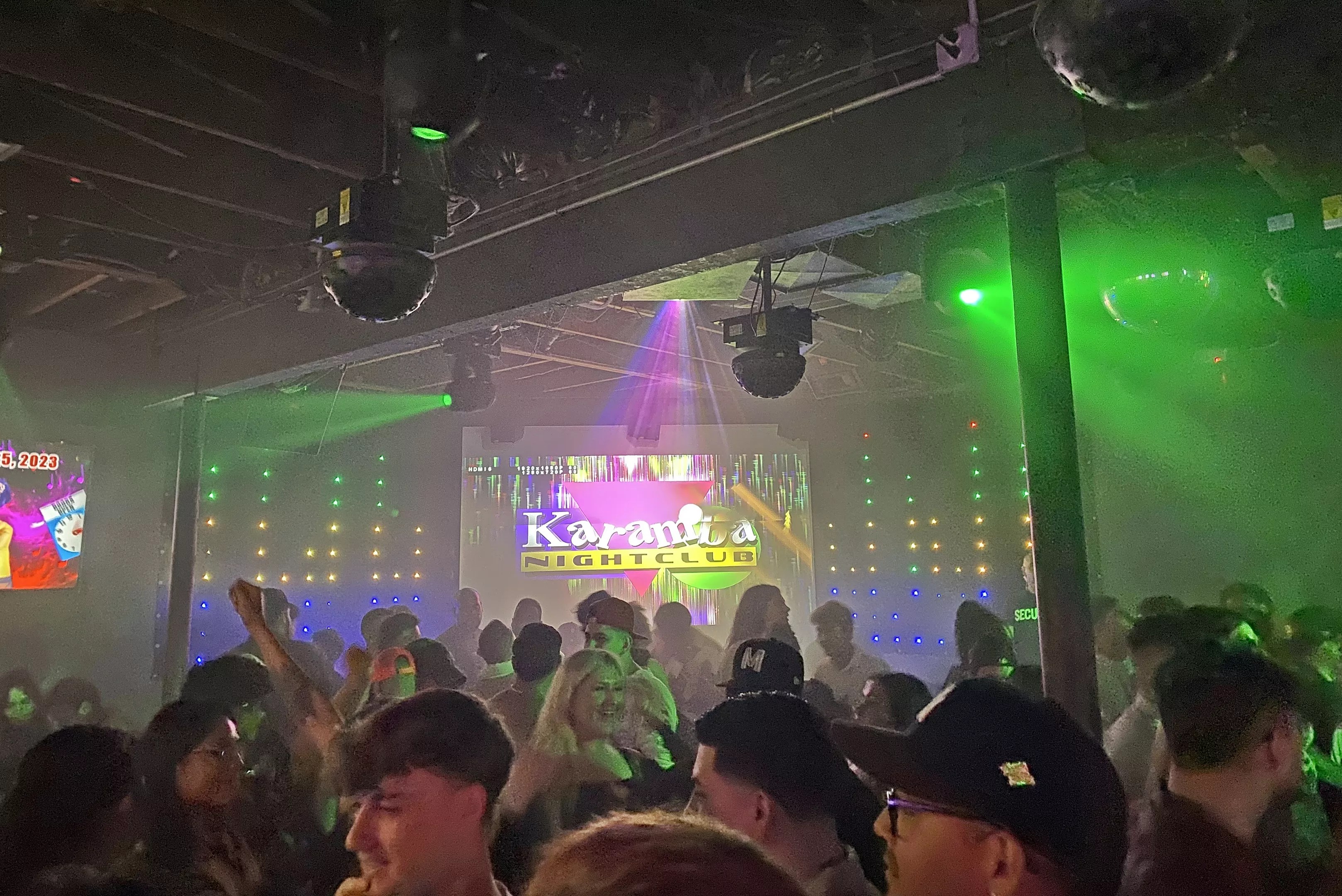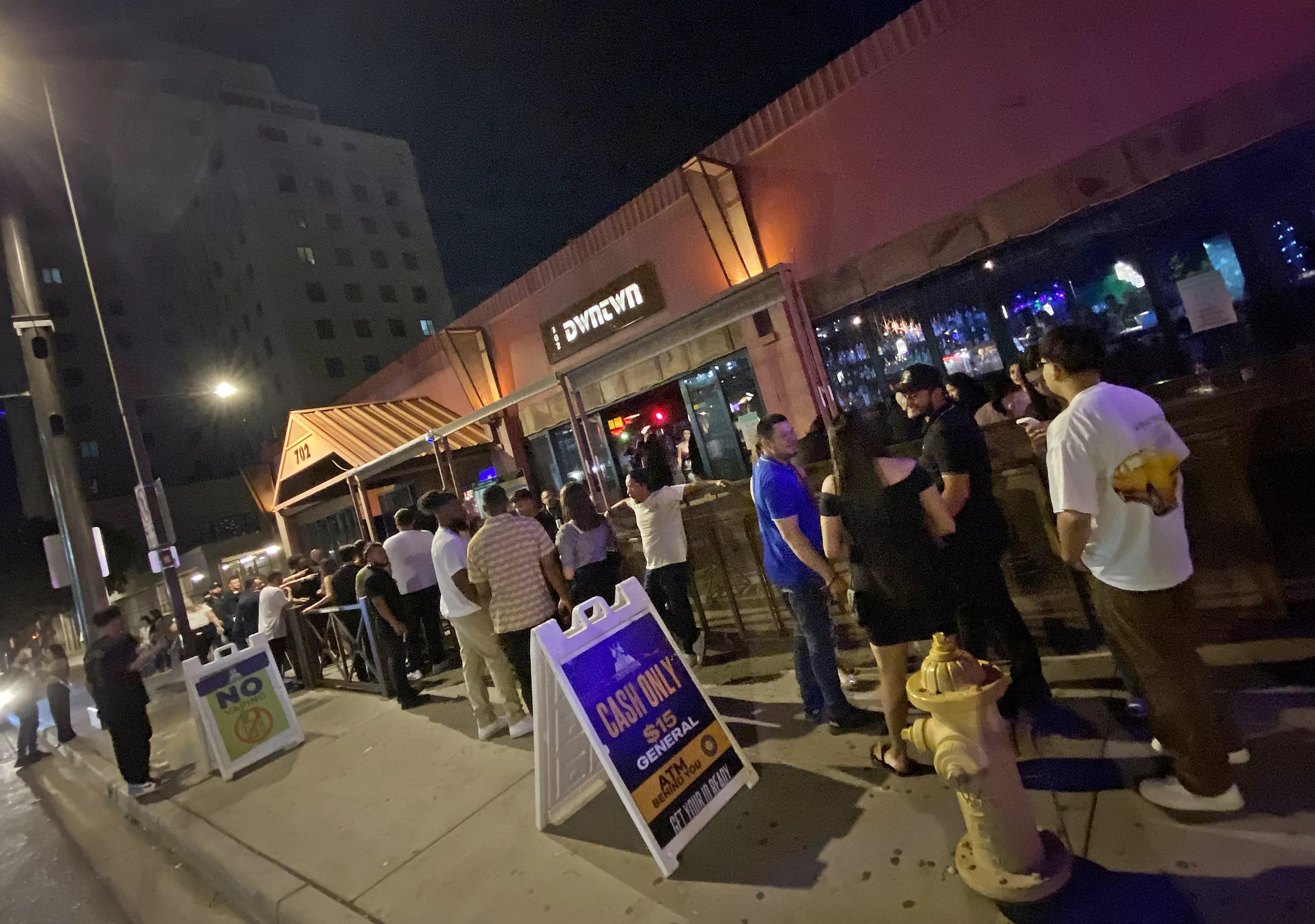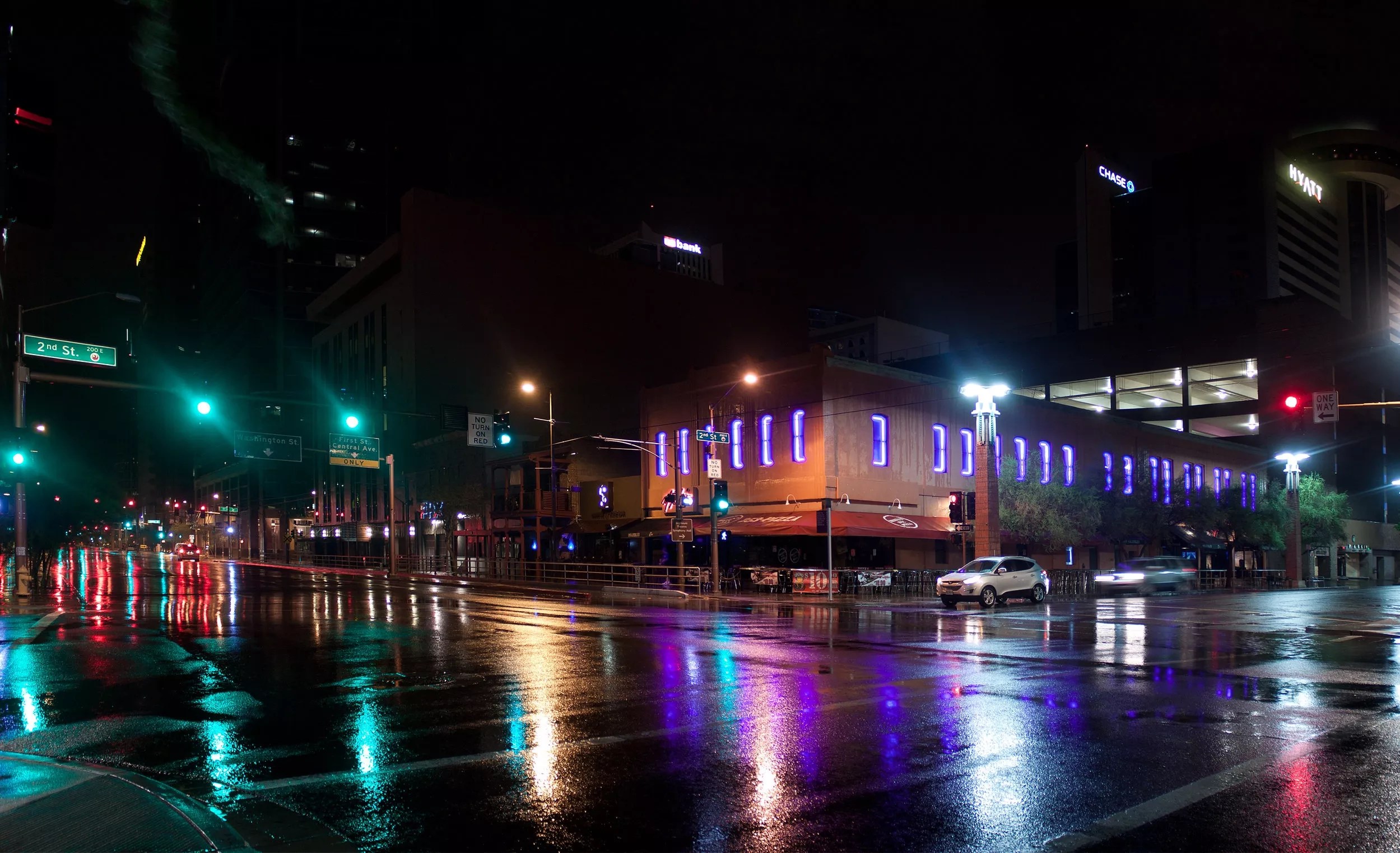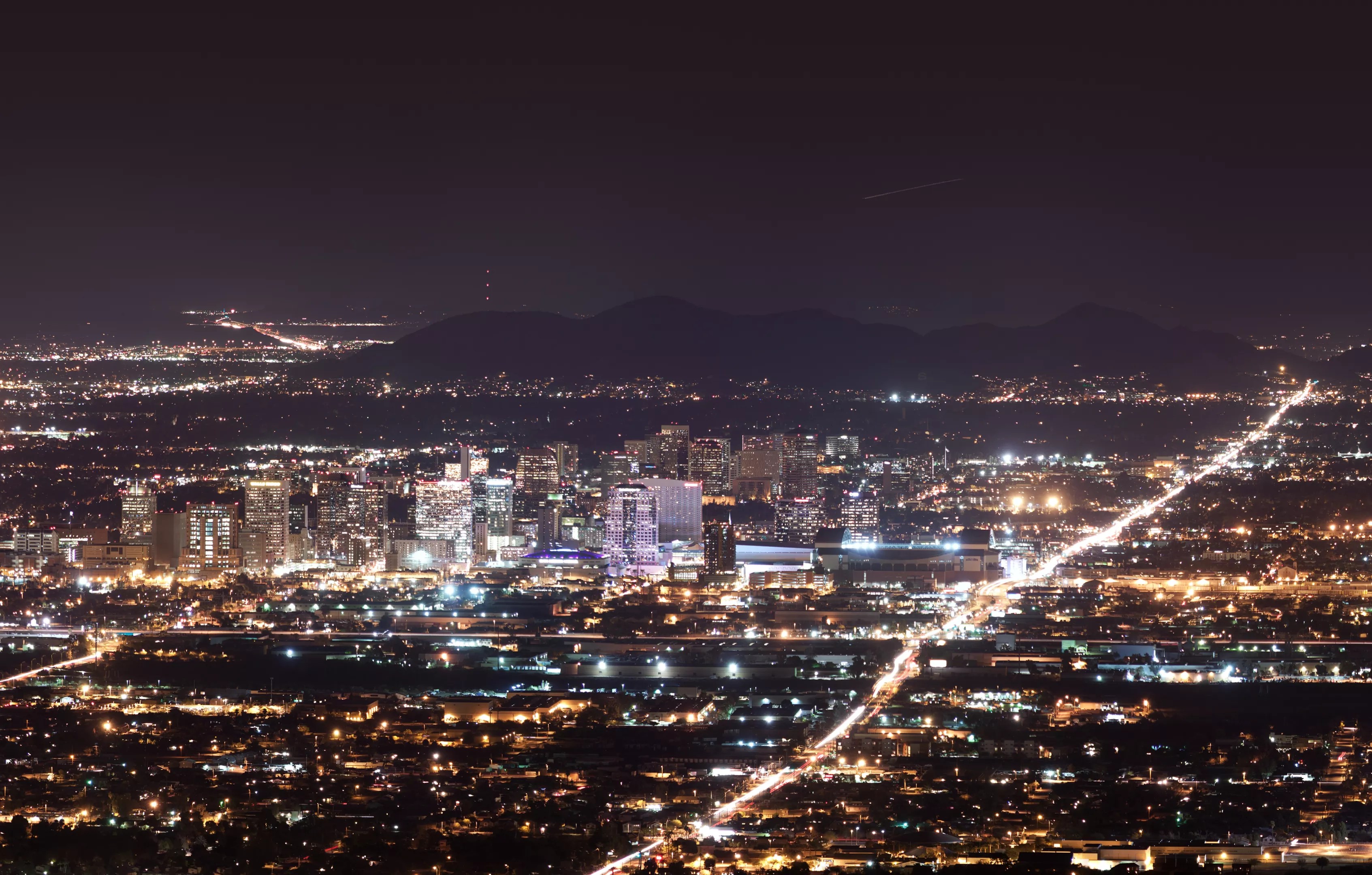
Benjamin Leatherman

Audio By Carbonatix
It’s after 3 a.m. on a recent weekend and the party’s still going inside Karamba Nightclub in Phoenix. Last call is a distant memory as the dance floor at the LGBTQ+ Latin spot near 17th Street and McDowell Road is filled with color and movement during one of its High Energy After Hours sessions.
As hip-hop and electronic dance tracks pulsate, vibrant lasers and spotlights illuminate young clubgoers of various ethnicities, sexual orientations and gender identities moving to the beat. The vibe is inclusive and the atmosphere is electric. The common denominator uniting this diverse crowd? Their mutual desire to go wild out on the dance floor until the wee hours.
There’s no booze fueling the late-night fun at Karamba, as its bar only sells non-alcoholic drinks after 2 a.m. The setup hasn’t been a total buzzkill for patrons, as the club has been a destination for post-last-call dancing for decades.
Karamba owner John Martinez says after-hours have been a hallmark of the property since before he bought it in 2004, back when it was called Boom Nightclub.
This year, make your gift count –
Invest in local news that matters.
Our work is funded by readers like you who make voluntary gifts because they value our work and want to see it continue. Make a contribution today to help us reach our $30,000 goal!
“The previous owner had it when it was Boom, and it was an extremely popular era [for the club]. Then it died off because the crowd moved on,” Martinez says. “So I came in with a completely different approach but kept [the after-hours].”
Karamba is among a handful of Phoenix nightspots offering dancing after last call on weekends. A few miles west, Latin club DWNTWN and its neighbor The Grand stay open past 3 a.m. Meanwhile, on Camelback Road near Seventh Avenue, landmark gay bar Charlie’s keeps its dance floor hot until 4 a.m.

DWNTWN on Central Avenue in downtown Phoenix.
Benjamin Leatherman
Why don’t other local clubs and bars keep things going after turning off their taps at 2 a.m.? The lack of alcohol sales is the primary reason, but there are others, some tied to COVID-related issues: Staffing shortages, the added expense of staying open longer hours and an overall lack of patrons late at night.
Many of these same factors are why a vast majority of Valley restaurants, bars, coffeehouses, retailers and other businesses don’t stay open past midnight, never mind the wee hours.
Kimber Lanning, CEO and founder of community and economic development nonprofit Local First Arizona, says that’s why Phoenix isn’t considered to be a late-night city
“We’ve just never been geared that way,” Lanning says. “Things have gotten better over the years, but no one’s going to mistake us for New York.”
Valley nightlife has come a long way from the days when Phoenix’s downtown became a ghost town after 6 p.m. and locals joked about cities rolling up their sidewalks after dark. There are now nightlife hubs like Roosevelt Row, Mill Avenue in Tempe and Scottsdale’s entertainment district.
But there’s still room for improvement, especially with the Valley’s post-2 a.m. landscape.
These days, locals can grab dinner and drinks at a majority of eateries or breweries until 10 or 11 p.m. As things get later, though, options decrease dramatically. After midnight, most upscale spots close. By 1 a.m., the vast majority of restaurants still open are of the drive-thru or Denny’s variety. When last call hits, bars and clubs goes dark.
Things are better on Fridays and Saturdays, as many nightspots cater to weekend crowds by staying open until 2 a.m. After that, though, local night owls searching for a decent cup of coffee after-hours or eats that don’t involve a combo meal are often left to wonder, “Why isn’t Phoenix more of the late-night city?”
It’s a topic that’s been widely discussed in social media circles by insomniacs, third-shifters and 24-hour party people on the regular. On Reddit, users ask variations of the question in the site’s locally focused subreddit r/Phoenix every few months.
The answers are almost always the same: The Valley’s population is too widespread, too old and unwilling to go out too late. Coupled with staffing and financial crunches spawned by the pandemic affecting the nightlife industry, the result is a city where people sleep on after-hours action.

Phoenix strip club Le Girls stays open until 4 a.m. nightly.
Benjamin Leatherman
‘Sprawl is the antithesis of late-night’
For the record, there’s life after last call in the Valley, albeit in extremely small doses and scattered across the Valley sprawl. There are a handful of strip clubs, pizzerias and late-night hookah joints open until 4 a.m. or later. For those in the know, off-the-radar house shows, raves and warehouse parties happen almost every weekend. And local casinos are always available 24/7.
Such scattershot after-hours options speak to the Valley’s lack of urban density, which Stephen Chilton, owner of The Rebel Lounge, says is the biggest issue facing Phoenix nightlife.
“Phoenix is so spread out that you’re competing for people all over, which means Uber rides are much more expensive if they want to drink, making it more difficult for people who want to go out late at night. Without decent public transit, if you’re trying to come downtown from Chandler, it doesn’t seem worth it on a regular Tuesday,” he says. “Late-night cities have a lot of density. In New York or Chicago, there’s density and it’s easier to get around.”
Lanning agrees.
“Sprawl is the antithesis of late-night [culture], so you’re going to see late-night make the most business sense in areas where there’s a lot of density,” she says.
Cities like New York and Chicago also attract a younger crowd, who are more likely to seek out late-night thrills, Chilton says.
“Those both are media-driven cities. There’s not a lot of entertainment-related or media-related businesses here, so there’s less young people here,” he says. “I think a lot of people move here after their 20s, so we’re disproportionately older than other major cities. We’re one of the oldest cities by population, so that’s going to affect it.”
Rodney Hu, owner of Tempe’s Yucca Tap Room, experienced NYC’s late-night scene firsthand while living there in his 20s during the early 2000s.
“There’s just so many different restaurants and bars and even specific areas in Chinatown or other parts of Manhattan that would be open some places till late nights until 2, 3 or 4 in the morning,” he says.
When Hu visited New York after the pandemic, the same spots had dialed back their hours in the wake of COVID.
“I asked the owners, ‘Why aren’t you open late nights?’ They said after COVID, they’d let go a lot of employees and had struggled to reopen,” Hu says. “It wasn’t as easy as saying ‘Okay, let’s open everything back up again.’ They’d had some major issues, some of it with staffing, some of it with money or having enough business.”
Phoenix’s nightlife scene, including its late-night spots, grapples with similar issues.

One of the entrances to The Grand in downtown Phoenix.
John Chakravarty
Making cuts after COVID
Veteran club owner Steven Rogers has experienced his fair share of late nights. His landmark mid-’90s Scottsdale dance joint The Works was a landmark after-hours spot. Many of his other establishments also operated late into the night, including now-defunct clubs Crowbar (now DWNTWN), Sanctum and Amsterdam.
One of his most recent creations is The Grand, a 15,000-square-foot space in downtown Phoenix that operated as a coffeehouse, restaurant, bar and hangout with a 24-hour kitchen after debuting in 2018.
After COVID hit, Rogers had to downsize operations at The Grand, starting with its hours.

Steven Rogers (right), co-owner of now-defunct Scottsdale club The Works.
Steven Rogers
“After the pandemic, I saw my mistakes at The Grand. When I reopened, I limited my kitchen and coffee service and turned it into mostly a bar. We still have a little food, but I was seeing people come in for coffee and camping out for hours,” he says. “You can’t make money if people sit around all night using your air conditioning and electricity after [buying] a cup of coffee. It’ll bankrupt you.”
The Grand wasn’t the only downtown coffee spot making course corrections after COVID. Jobot Coffee & Bar along Roosevelt Row began closing earlier after operating nightly until 2 a.m. for years. Owner John Sagasta says financial concerns were among the reasons.
“Staffing is a big part of it. Labor’s more expensive now with [wages] going up. So that’s a big increase,” he says. “If you close at 10 p.m., you definitely have less insurance to carry, which means you have less premiums to pay.”
It’s not the first time Jobot changed its closing time. At its original home inside a Fifth Street bungalow from 2009 to 2017, the coffeehouse operated as a 24/7 cultural hub and hangout. Sagasta says it felt safer those days than at their current location along RoRo.
His feelings about operating hours are rooted in tragedy. In October 2018, Jobot employees David Bessent and Zachary Walter were shot to death outside the business after leaving work at 3:30 a.m.
“A lot of it is safety concerns. When we’d stay open until 2 and a lot of times (Jobot employees) didn’t feel safe, ’cause somebody would walk in and they’d have a situation on their hands,” Sagasta says. “I’ve thought about doing all nights on the weekends a few times, but I feel a little more vulnerable than I do on Fifth Street.”
Chilton says the pandemic changed everything for late-night businesses.
“Pre-COVID, there was definitely an attitude of ‘If you can be open, you should be open,'” he says. “But with staffing problems and how tight it’s gotten for entertainment bars and restaurants since then, a lot of people now look at it like, ‘It doesn’t make sense to be open at 1 a.m. on a Tuesday.'”

Downtown Phoenix’s bars and nightclubs along Washington Street.
Alan Stark/CC BY-SA 2.0/Flickr
A late-night rebound?
If there was ever a golden age for all-night fun in Phoenix, it was likely in the late ’90s and early 2000s. After-hours joints like now-defunct Mickey’s Hangover in Scottsdale were thriving. Coffeehouses like Tempe’s Gold Bar Espresso were open 24/7. Rave culture was at its zenith thanks to the popularity of EDM and MDMA. Comedy Central even filmed an episode of its late-night travelogue show “Insomniac with Dave Attell” in the Valley.
Rogers says the popularity of after-hours at the time was due to Arizona cutting off liquor at 1 a.m.
“The driving force in after-hours was bars closing at 1 a.m. People weren’t ready to go home,” Rogers says. “It also created a market for people under 21.”
Things changed in 2004 when the Arizona State Legislature extended last call to 2 a.m. Chilton suspects that’s as late as it will ever go, noting “there’s no energy or interest in Arizona to change it,” he says.
If Phoenix becomes a true late-night city, it will be by other means.
Sagasta believes as the nightlife scene continues to recover from COVID, it will also take people running after-hours events, even if they lose money at first.
“It’s just a matter of someone being willing to stick their neck out, step up and open up,” Sagasta says. “They’ll have to have all the right things in place, like location and staff.”
He’s already testing the waters. Earlier this year, Sagasta began bringing in Mexican food carts like Baja Roots to operate until 2 or 3 a.m. in front of Jobot.
Lanning says the Valley’s current nightlife hubs need to develop further.
“Late-night places are going to tend to be around areas with a lot of housing density: Old Town Scottsdale, downtown Tempe, and downtown Phoenix,” she says. “And I think you’ll see more as more people moving there to adopt an urban lifestyle. We’re playing catch-up in the density department.”
Scottsdale’s entertainment district already has a handful of after-hours spots, including a hookah bar (Oasis), a taco joint (Mesquite Fresh Street Mex), and two pizzerias (Gus’s and Joe’s NY Pizza).
Sean Watson, a veteran club scene DJ, says the smarter bet for developing a late-night hub is on Roosevelt Row. He points to a steady influx of new late-night restaurants and bars in the area in recent years, including spots like pan-Asian eatery Disco Dragon and its adjacent speakeasy Fuck You Pay Me. And there are more on the way.
“From my knowledge, there’s going to be a bunch of new venues opening up that are catering to late-night people,” he says. “People love new … and new is coming.”

A view of Phoenix’s skyline at night.
Alan Stark/CC BY-SA 2.0/Flickr
While Watson was mum on further details, he says RoRo also offers the necessary urban density, public interest and cool factor to succeed.
Plus, the area might be getting a big assist from the city. In June, Phoenix officials began the preliminary phases of creating an entertainment district downtown. According to Christine Mackay, the city’s Community and Economic Development Department director, the project would be part of expanding the Phoenix Convention Center and would also include a walkable area with 24/7 nightlife.
As Mackay told “Arizona Horizon,” the public affairs show on Arizona PBS, the district would be akin to bar-heavy areas like Austin’s famed Sixth Street or Honky Tonk Highway in Nashville.
It also could potentially include RoRo, she says.
“Clearly, it would be around [Chase Field] and [Footprint Center], and then our convention center, but when you think about Roosevelt Row and the First Friday art walk and walking up into that area, it feels like it should connect all the way up into that area,” Mackay told “Arizona Horizon.”
The Phoenix City Council voted unanimously on June 28 to hire consultants to guide the project forward. It could be years in the making, but Martinez says the entertainment district is a potential game-changer for Phoenix nightlife.
“I think (Phoenix is) finally coming around to wanting to have an entertainment district,” he says. “They’re coming to terms with what Scottsdale did years ago (with its entertainment district) to have more life downtown. We might be finally starting to see something truly vibrant down here.”